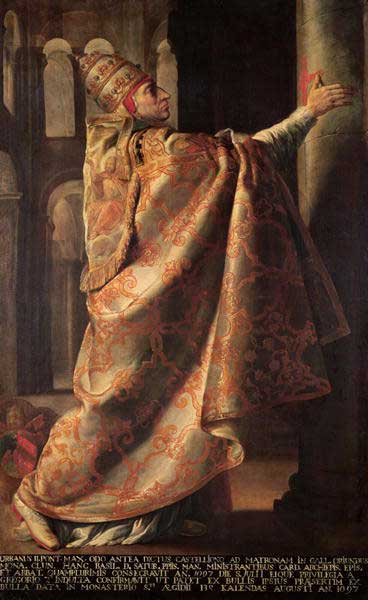Saint Urban II Catholic Saint
- 28-Dec-2023, 19:38
- 4 398


Saint Urban II
Catholic Saint
Feast Day : July 29
Also known as: Otho; Otto or Odo of Lagery
Urban was born to a noble family at Châtillons-sur- Marne, Champagne, France, and christened Odo (sometimes written Otho or Otto). Odo studied under St. Bruno (later founder of the Carthusian order) at Reims. He became archdeacon there, and, about 1070, joined the Benedictine monastery at Cluny, of which he was named prior by the abbot, St. Hugh. After a few years, Odo was sent to Rome to assist Pope St. Gregory VII (r. 1073–85) in his Church reforms. In 1078, Gregory created him cardinal-bishop of Ostia. From 1082 to 1085 he was the papal legate to France and Germany, and was briefly imprisoned by the Holy Roman Emperor Henry IV in 1083. He returned to Rome upon Gregory’s death in 1085, and served in the Vatican under the following pope, B1. Victor III (r. 1086–87).
Both Gregory and Victor having proposed him as their successor, Odo was unanimously elected to the Chair of St. Peter on March 12, 1088, whereupon he assumed the name Urban II. The reigns of Gregory and Victor had been troubled by the antipope Clement III (Archbishop Guibert of Ravenna), who had been seated under the influence of Henry IV in 1084. Clement was in control of Rome at the time of Urban’s succession, and Urban was able to enter the city (with Norman assistance) for the first time only in November 1088. Because of the support Guibert enjoyed, however, Urban had to take refuge on the island of St. Bartholomew. He was not able to enter St. Peter’s until after a three-day battle that drove Guibert from Rome. Urban left Rome again in the fall of 1089 to attend a council of bishops at Melfi, in southern Italy, but when he tried to return to the city in December, he found Guibert there again. Guibert celebrated Christmas Mass in St. Peter’s while Urban anathematized him from outside the walls. Unable to enter the city, Urban then began a three-year tour of southern Italy, holding councils that promulgated decrees against simony, cler- ical marriage, and the royal investiture of bishops and monasteries without prior church approval. By 1093, Urban was in desperate straits, deeply in debt and dependent on charity.
A French abbot, Gregory of Vendôme, came to his assistance, and when the governor of the Lateran Palace offered to surrender it to Urban for a fee, Gregory raised the ransom by selling possessions of his monastery. Urban was able to return to St. Peter’s in time for the Easter solemnities. Once again, he did not stay long in Rome, but left, this time traveling north into France. He convened councils that took strong stands in favor of ecclesiastical discipline and other matters of consequence to the Church. The most important council of this period was held at Clermont (Claremont) in Auvergne in November 1095. In response to a request from Emperor Alexis I in Constantinople, Urban declared the Truce of God and proposed a crusade to retake Jerusalem from the Muslims. The call met a sound response, and Urban began traveling around France to drum up further support. Although he was urged repeatedly to lead the crusade, he appointed Ademar, Bishop of Le Puy, in his place. The First Crusade was launched in 1097 and on July 15, 1099, reclaimed Jerusalem. Victory came before Urban died, but he did not live to hear the news.
He passed away in Rome on July 29, 1099. Guibert’s followers prevented his burial in the Lateran and his relics were conveyed instead to the crypt of St. Peter, where they were interred close to the tomb of Pope Adrian I (r. 772–795). Urban is listed as a saint in many medieval martyrologies. According to Guibert of Nogent, miracles attended his tomb, and his cultus seems to have formed at the time of his death. His feast day, however, was never extended to the Universal Church. Urban appears in a painting in the apse of the Lateran Palace oratory built by Pope Callistus II (r. 1119–124). He is depicted at the feet of Our Lady, his head is crowned by a square nimbus, the words sanctus Urbanus secundus beneath him.